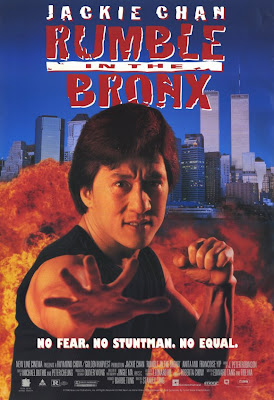Pom Poko (1994) This lesser-known animated film from Studio Ghibli follows the exploits of a group of raccoon dogs or tanuki (referred to simply as raccoons in the dumbed-down English translation), as they endeavor to survive the incursion of their habitat by humans and their Tama Hills suburban Tokyo development project. Many of the tanuki possess transformative abilities, which they use to varying degrees of success to confuse and temporarily stave off the human invaders. Initially, the transformations are played for laughs, but there is a darker side at work. We see their environment rapidly diminishing, and their efforts to hold off the humans become more desperate and futile as time goes on. There were times when the animals versus humans theme reminded me of Over the Hedge, which came more than a decade later and could have been influenced by Pom Poko, but the themes are much more complex here. The main characters rise above stereotypical depictions of cute cartoon animals, and it’s clear that they have a rich history and cultural background. Shinto tradition and spiritualism plays a prominent role throughout the film. Director Isao Takahata was responsible for the emotionally devastating anime film Grave of the Fireflies, and he lends a weight to the story that emphasizes the life or death stakes. He hits all the right notes, in a bittersweet story that’s sometimes funny, sometimes tragic, and ultimately accepting of an end to a way of life.
Rating: **** ½. Available on DVD.
The Illustrated Man (1969) Rod Steiger stars as Carl, the illustrated man, in this heavily flawed adaptation of the Ray Bradbury anthology. Three stories run from middling (“The Veldt”), to competent (“The Long Rain”), to awful (“The Last Night on Earth”). The stories are bracketed by a narrative concerning a young man named Willie, traveling the road from New York to California in the 1930s, on his way to a new job and a new life. Willie encounters Carl, who has been tattooed from head to toe with illustrations (“Don’t you ever call them tattoos!” he screams.) that come alive. During the rest of the film, Willie is subjected to rants from Carl, who is on a quest to find the mysterious woman who covered his body in this artwork, and determined to kill her for ruining his life. For an anthology film, this bracketing story thread goes on much too long. The filmmakers could have easily added another segment without lengthening the overall running time significantly. Steiger’s character just comes across as unstable and unsympathetic. In a role that called for subtlety and pathos, it just seemed like an opportunity for him to overact.
Rating: **. Available on DVD and Netflix Streaming.
Crucible of Horror (1971) The title is somewhat misleading, since this is more of a family drama/thriller than a horror film. The late Michael Gough stars as an overbearing father in a dysfunctional British household. His wife Edith paints morose portraits, and seems to be in a continual depressive state, while his daughter is the recipient of the lion’s share of his physical and emotional abuse. His son (played by Gough’s real-life son Simon) is the obvious favorite, as he seems to be exempt from the wrath that he exacts on the rest of the family. After enduring years of physical and psychological abuse, the mother and daughter conspire to murder him. Things don’t go quite as planned, however. I wasn’t sure if the director was trying for a Hitchcock-style thriller. If so, he falls short of these aspirations, displaying little of the wit or tension found in even Hitchcock’s lesser efforts. The pacing of Crucible of Horror is slow, and the atmosphere is relentlessly dour. There are no major missteps, but nothing exceptional either, outside of the senior Gough’s performance. It’s not the sort of thing I would care to see again, but if you’re in the right mood it might be worth a look once.
Rating: ** ½. Available on DVD and Netflix Streaming.
Highway to Hell (1991) If you only learn one thing from Highway to Hell, don’t stray too far from the interstate when traveling in the middle of the night, and if you do, remember to stay caffeinated. Chad Lowe and Christy Swanson (Don’t let the casting scare ‘ya!) play a young couple, Charlie and Rachel, on their way to Las Vegas to elope. Paranoid that a policeman is pursuing them, Charlie veers his battered Ford Pinto off the main interstate onto a minor highway. They stop at an isolated gas station aptly named “Last Chance,” where the couple receives a dire warning from its elderly proprietor (Richard Farnsworth) to keep alert on the road. Naturally, his warning goes unheeded, and they’re soon pulled over by a strange police car and its stranger occupant, Hellcop. Before they realize what’s just happened, Rachel is strapped in handcuffs (literally, in this case), and the demonic policeman drives away with her in tow. Now it’s up to Charlie to rescue her before the Hellcop reaches Hell City and she becomes a permanent resident. Highway to Hell is a little rough around the edges due to obvious budgetary restrictions, and not all of the gags work, but its quirky sense of humor shines through. Some highlights are the Good Intentions road crew, staffed by multiple Andy Warhols, and Adolf Hitler (played by Gilbert Gottfried) who insists that they’ve got the wrong guy in hell. Also, watch for cameos by Ben, Jerry and Amy Stiller. It’s fairly evident that this was not made for mass appeal, but for late night B-movie viewing. In this case, the parts are probably better than the whole, but there’s really nothing else quite like it. For some strange reason Highway to Hell was never officially released on DVD, but if you have Netflix Streaming, I recommend giving this a try.
Rating: *** ½. Available on Netflix Streaming.




























